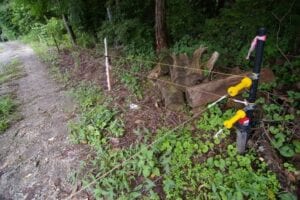Cattle Feeding
You want to have plenty of fodder on hand at all times of the year for your cows to thrive, so you mustn’t overstock you pastures. Ideally, you have enough space to pasture your cow(s) and let them self-feed year-round—this is the least labor-intensive way to farm livestock, period.
During the growing seasons, grass should be abundant, but it can be scarcer in winter and at the height of summer, so it’s important to let land rest and rejuvenate, hence the need to economize herd volume to land size.
Let’s assume that you have sufficient grass to achieve optimal nutrition without supplemental feeding…
The tricky part comes when estimating how much stored forage crops you need for the cold or particularly dry months when the grass is not growing and you will need to feed hay or silage or tree forage.
Save It For A Non-Rainy Day…
You may need to feed for around 120 days in the winter and another 40 days in summer, especially if there’s drought.
A beef cow in mid-lactation will consume anywhere between 24 and 32 pounds of hay per day on a maintenance diet (depending on the quality of the hay). In other words, around 2% of her body weight.
Given that hay is about 10% dry matter, this can translate to around 300 pounds of wet grass that needs to be cut and made into hay.
You will need 160 days’ worth of hay per cow. At 30 pounds per cow, that works out to about 4,800 pounds of hay per year, which is equivalent to 24 tons of fresh grass per year.
Due to the enormous weight, the difficulty of handling, the labor of cutting, plus the storage of it—without talking about the actual acreage needed to grow it—the small farmer is probably better to buy this type of fodder.
The same can be said of the supplemental feeds or concentrates—which are especially needed for dairy farming.

That said, it is entirely possible and probably preferable to not buy in any fodder crops. With careful management of resources and
the use of fodder banks and root vegetables as fodder (e.g. turnips, kales, and different varieties of canola oil seed plants). These can be self-fed (the herd will eat it without any additional labor from you) and are efficiently cultivated with the use of a simple movable electric fencing system, which is both cheap and easy to move.
This ability to self-feed is a huge labor-saver as well as being inexpensive. Depending on your location, you should be able to set up fodder banks full of high-protein plants that can be self-fed or are relatively easy to cut and carry on a daily basis. Many of these plants can also be easily and effectively made into silage for feeding whenever needs arise.
Mulberry, moringa, and Terminalia amazonia (sometimes called nargusta) are good examples that can be grown in a wide range of climates, soil types, and locales. Here, again, your neighboring farmer can be a great source of information for what will work best in your region, as can local universities and department of agriculture extension officers. I cannot overstate the value of opinions from these folks.
Many departments and institutions in various countries have grants and/or programs available to supply you with planting materials and technical advice—or even some seed money—pun intended—to help you set up. (Veterinary services may also be available at a reasonable cost from vet schools if you are lucky enough to have one nearby.)
Remember: The more homegrown feed you produce, the more you can keep your costs down. It also gives you the satisfying knowledge that you know exactly what your animal—your own food source—has eaten to produce the milk, beef, cheese, yogurt, and whatever you produce from it that you and your family eat.
The peace of mind that comes with knowing that you produced the healthy, wholesome food you put on the table from ground to animal to table cannot be underestimated; it’s a great source of pride.
Growing all of your own cattle feed, though, does mean more physical work for you…
A happy medium can be struck between growing your own feed and buying in some essentials.
Tomorrow, we talk breeds…
